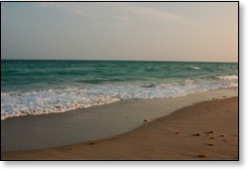
He was a co-author of a study from the University of Central Florida.
It was typical of other articles which play on people's fears. I prefer facts over fears.
The Raleigh News & Observer gave credibility to the story by publishing it as part of an article, "Double threat."
We have plenty of time to still get whacked in the 2007 season. The seas are warm and the high pressure area that has been protecting us is weakening. Still bad news sells and the idea that Carteret County was at the top of the hurricane list was certainly widely publicized bad news.
Still it is time to clear up some of the misconceptions about hurricanes. Hurricanes need plenty of respect, but I am not sure I want to let fear of hurricanes keep me from enjoying a coastline where most of the year, it is as safe or safer than other parts of the country.
First of all, let me say that hurricanes can be tremendously devastating both on the shore and inland. It doesn't come as much surprise to coastal residents that 59% of hurricane related deaths come from fresh water flooding. The tidal surge which is often the most hyped in the media accounted for 1% of deaths in the 1970-1999 period.
While people often fear living on the coast because of hurricanes, there is little understanding of what happens when a fully loaded east coast hurricane hits the mountains. This article, What Happens when Hurricanes Move Inland, along with this NOAA article, Inland Flooding, make some interesting points including the fact that of the 56 people who died during hurricane Floyd, 50 of them died from inland flooding.
The total precipitation map from Floyd shows much of the intense rain happened inland. Hurricane Camile in 1969 produced up to 31 inches of rain in the Blue Ridge Mountains. One report had that 31 inches of rain falling in six hours and causing the Rockfish River to rise 30 ft.
This last week in August 2007, intense storms in the mid-West caused 17 deaths. Flooding was a big part of the problem.
Hurricanes like Floyd can cause a tremendous amount of damage and force thousands from their homes. Yet it isn't always the coast where the brunt of that destruction falls. Sometimes it is and sometimes it isn't. With Floyd most of the damage was east of the coast.
In 1955 Hurricane Dianne caused massive damage and over 180 deaths in Pennsylvania, New York, and New England.
Where hurricane damage will occur is no more a sure thing than the prediction that Carteret County is the top hurricane target for this year.
I looked at the same data and made a far different assumption. My thought was that the full impact of recent storms have tended to avoid the area. It was the same data with different people drawing opposite conclusions.
Whether or not that is a run of luck that will continue or a streak that will end this year, is no reason for people to panic. The Southern Outer Banks of North Carolina is no New Orleans.
I don't care where you live there is risk. If you live directly on the beach of a barrier island, your risk is much greater than if you live five or six miles inland. Your flood insurance will reflect that and likely you won't have to have some wind velocity insurance. If you live in a regularly flooded mountain river valley, you will also be carrying flood insurance and may have less of a flood warning than you would if you are living on the coast.
The coast of North Carolina is a beautiful place to live. It has some risk, but so does Raleigh two hours inland. Some folks are brave enough to live on the barrier islands. Many of us live a few miles inland and still get to enjoy the beaches.
I don't plan to ride out any hurricanes when I am told to evacuate, but I am not going to miss living in one of the most beautiful spots on earth because a hurricane might hit.
The facts are that North Carolina, which is a big state, has been hit by hurricanes fifty times in the 155 years from 1851 to 2006. Will global warming increase that number? Time will tell, but I am hoping to enjoy several years here riding around in my skiff while the scientists are arguing about that.
Even with the flood insurance necessitated by living on a tidal river, my total recurring costs (insurance plus property taxes) on similar homes is 35% less in Carteret County than it is six hours away in Roanoke County in the Virginia mountains. Insurance is more expensive but property taxes are a fraction of what they are in Virginia.
More information about Carteret County.

